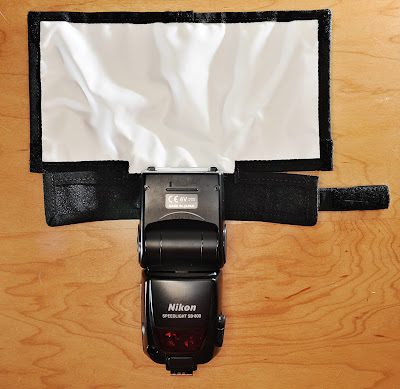
I know what you are thinking — this snoot looks a little familiar, perhaps?
Well, it is — and it isn’t.
Actually, better lemme explain.
__________
Okay, long story short — and without going into too much detail:
Honl creates a line of snoots and gobos. Sells them independently. Signs with ExpoImaging as distributors. A falling out occurs. Honl back to independent. ExpoImaging releases new line of Rogue FlashBenders.
So now you know some backstory. And yeah, there is a certain level of familiarity involved. But they are different enough to make them of interest, so here goes.
Mounting Tension

There are a few differences between the Rogue FlashBenders and the Honl stuff. But for me the special sauce is in the way they designed their mounting system.
The speed strap is elasticized, and built into the snoot itself. It attaches with a nice (and consistent) amount of tension. The edges of the snoot attach with velcro, like so:

Advantages: Quick mounting, and the strap is always with the mod.
Disadvantages: You’re essentially gonna pay for a strap with each mod. Whereas you might be able to get by with, say, four mods and two straps otherwise.
Horses for courses. And depending on what configuration you end up with, one system might be priced better for you than the other.
One area in which Honl snoots do best the Rogues is in reversibility. Being able to choose which surface you want on the inside of a snoot means that you can alter the internal reflectance of the snoot — and thus the quickness of the fall-off at the edge of the beam.
Since the FlashBenders have a white interior, you are always going to get a wide feather to the edge of the snoot’s beam. You can see it what I am talking about in the photo directly above.
I make my homemade cardboard snoots reversible from end to end (black interiors one end, white on the other) just for that reason.
Get Bent
Conversely, the FlashBenders do add a feature over the Honl models in that they have an internal set of thick, diagonal wires. This allows a kind of “twisty-tie” capability in that you can lock it into just about any shape you want if using it as a bounce card.
Personally, I do very little (if any) bounce card-type lighting. But I know a number of you do shoot that way (receptions, parties, etc.) and it would seem to be more versatile for those folks.
The wires do add weight. Not an issue for just one or two units, but if you have a stack you could tell. Feels kinda like one of the X-Ray proof film bags back in the day. (They were, of course only X-ray proof until the opaque image they gave on the machine caused the operator to crank the volume up until your film glowed in the dark.)
There is a large and small version of the snoot / bouncer / bendy thing. There is also a straight bounce card/gobo version, which does have a black insert or a white backing for versatility.
More info / prices, etc., at ExpoImaging.
